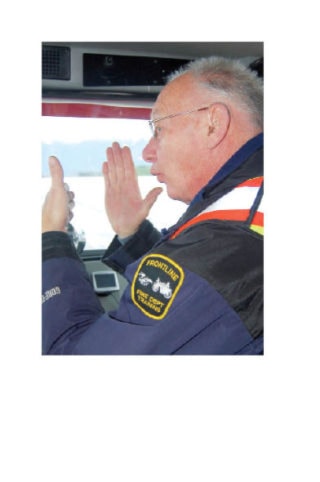Thornhill firefighters came out in their spare time to practise ice driving in a fire engine at the Northwest Regional Airport late last month.
But when rain washed away the ice and snow, firefighters honed their skills in learning how to handle the truck slowly and smoothly.
Driver trainer Bob Weicker of Frontline Fire Dept. Training Inc., who has been doing his job for about 16 years now and trains drivers in B.C., Alberta, the Yukon, Ontario, and California, gave instructions to drivers from the passenger seat with explanations of the reasoning behind what they were doing. The smooth movement of the steering wheel is what keeps the truck on the road when it’s icy and slippery, he said.
Firefighters drove the fire truck around tall orange poles set up in a straight line down the airport tarmac, passing by the right side of one pole and manoeuvering the truck around the left side of the next pole in a weaving motion, according to Weicker’s instruction. It’s important to stay close to the posts but not too close; try to keep two to three feet away from the posts when passing with the back tires, he said.
When weaving, make sure the poles can be seen behind the cab in the side mirror before you turn the steering wheel so you don’t knock them over, drivers learned.
An example from real life is if you want to turn into a narrow driveway, you have to swing wide because if you don’t, the back end will swing into the ditch, said Weicker.
The exercise instills in firefighters the fact that they must drive smoothly; by giving them a course where they have to change the direction of the fire truck quickly and repetitively, they learn to drive smoothly, explained Weicker.
Drivers would take the truck around one of two turning lanes marked by pylons at the end of the driving course, either a wide lane or a narrow lane. The two lanes show the differences in vehicle dynamics in a tight turn and a wide turn such as showing how a person enters a turn by entering wide, coming close to the centre point of the turn and exiting wide to reduce the amount of sway and roll of the vehicle, he said.
And it shows how a wide smooth entrance differs from a sharp entrance, which may cause the vehicle to lose traction and slide.
Weicker not only trains driving but anything else that has to do with the fire truck, such as aerial and pump training.
